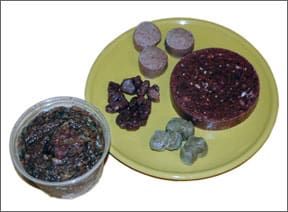We have long maintained that an intelligently formulated diet, made in a dog owner’s home out of fresh, wholesome ingredients, is the ideal diet for optimum canine health. The tens of thousands of dog owners who make their dogs’ food at home agree. Their dogs enjoy their food; look, smell, and feel terrific; and enjoy vibrant good health.
However, some people who would really like to feed their dogs this way don’t feel capable of routinely shopping for and preparing their dogs’ food. Others worry that their dogs might suffer from a nutritional deficiency or imbalance if they don’t formulate the diet just so. These folks are the target market for the products featured in this article: diets made of fresh ingredients (mostly meat) and frozen for convenience.
There is a lot of variation within this product category, however. Some of the companies offering frozen, meat-based diets for dogs include raw ground bone as a natural, healthy source of dietary calcium; others incorporate eggshell or another calcium source. Some include grain in these diets; most do not. Most (but not all) contain at least a small amount of organ meat, fruit, and vegetable matter.

288
Some of these products contain a pre-mixed vitamin/mineral supplement, to ensure that the diet is nutritionally “complete and balanced” as per the nutrient levels recommended by the Association of American Feed Control Officials (AAFCO). Others meet these nutrient levels (and thus earn the right to make the complete and balanced claim) through their food ingredients alone – without the addition of a vitamin/mineral “premix.”
Still other products are meant for “supplemental” feeding only, with the idea that the owner will continually vary the diet in order to provide nutritional “balance over time.” Companies that sell supplemental products generally offer a wide array of frozen, raw ingredients – as well as guidance on how to mix and match these to provide a complete diet.
Quality varies
Just as with every other type of pet foods, including kibble and canned, the ingredients used in these diets vary in quality. Some use only human-grade ingredients, meats that come from free-range, grass-fed animals, and local and/or organic fruits and veggies. Others use less-expensive ingredients. The difference here, though, is that almost all of the ingredients in these products are higher in quality (and price!) than those used in most kibbled or canned foods. Fresh, wholesome, and natural are the watchwords for this category; it’s expected that resulting food will look and smell fresh and appealing when thawed.
Presentation and packaging varies within a small range in this category. Some companies grind their food ingredients into a very fine “mush” that, when thawed, resembles canned dog food. Others use a coarse grind, enabling the pet owner to identify various ingredients by sight. Products may be formed into cube-like “nuggets” or hamburger-style patties, packed into plastic tubs (like cottage cheese), or pressure-packed into plastic tubes generally referred to as “chubs.”
As to availability and shipping: Most of the companies that sell frozen diets offer direct shipping, via overnight service, right to your home. This practice is incredibly convenient – but also increasingly expensive and quite unkind to the environment; it takes a lot of Styrofoam, and sometimes a lot of dry ice and cardboard, too, to ensure these products are still frozen when they are delivered to your door.
Most of the companies sell the bulk of their products through pet supply stores that are equipped with freezers. This is most advantageous for owners who live in close proximity to one of these stores (or veterinary offices), since they don’t have to pay for shipping and can take the products directly home and put them in their own freezers.
Commonalities
So what do all these diets have in common? They all contain fresh, raw meat: muscle meat, fat, and connective tissues. They are all based on the concept that uncooked animal proteins offer the most complete array of amino acids required by canines, providing the most important building blocks of the natural, evolutionary canine diet.
This concept was championed in recent decades by Australian veterinarian Ian Billinghurst, who sought to bring back the vibrant health he remembered seeing in the dogs of his youth, before commercial foods were widely used in Australia. But Dr. Billinghurst sought to replicate the evolutionary diet of the dog, where any raw meat the dog ate would come wrapped around bones and organs of the dog’s prey; he called this sort of diet “BARF,” which alternately stood for “bones and raw food” or “biologically appropriate raw food.”
Dr. Billinghurst saw the consumption of raw bone and organ meat as an integral part of this type of diet, but others who followed in his footsteps found that the raw meat was the key to the diet’s success. They use other calcium sources rather than raw bone in their formulas and feel that the diet is just as beneficial.
Be forewarned: The arguments between the people who feel that raw, meaty bones must form the basis of these diets and those who think the raw meat itself is the key absolutely resemble the arguments between believers of related but divergent religious sects. Each is certain that only they know the light and the way. Our opinions are ecumenical. If a diet is mostly comprised of fresh, whole, raw meats; contains all the nutrients known to be required by dogs; and your dog thrives on it, it’s okay by us. We suggest that newcomers to this style of feeding start out by feeding a variety of complete and balanced products, keeping a record of the results in each dog they feed, and ultimately going with the diet style that works best for their dogs’ individual needs and tolerances.
A few good foods
On the following pages, we’ve listed a number of makers of commercial raw diets. To assist those who are new to this style of feeding, we’ve separated the “complete and balanced” diets into the chart on pages 6-7, and the “supplemental feeding” products offered for more experienced raw feeders into another chart on page 8 (some companies will appear on both charts).

288
As with any type of commercial diet, we suggest contacting the manufacturers for more information about their products. Ask them how their products can help you meet your dog’s needs; they have a wealth of experience and a vested interest in helping to demonstrate the benefits, not the pitfalls, of this method of feeding healthy dogs.
The more questions you ask, the more opportunities you’ll have to ascertain what their level of commitment is to providing clear, credible guidance for feeding your dog in an optimal way. We also suggest that you ask about the following:
- Information about their formulation. Is it complete and balanced? Does it require other supplementation? Who was involved in the product formulation? What are that person’s credentials in animal nutrition? If you have a very technical question about the product’s nutrients, can they refer you to a nutritionist or vet with advanced study in nutrition?
- Information about the nutrient content of the products (more information is better than a minimal report). Does the company offer only the “guaranteed analysis” (which is required to detail only the protein, fat, moisture, and fiber content of the food) or a complete analysis that lists all of the values for the product’s vitamins, minerals, and fatty acids?
- Information about ingredient sources. Where does the company get their meats and other ingredients? Can they provide documentation to confirm the provenance of the ingredients?
- Information about the company’s food safety program. What sort of tests and/or food safety steps does the company take in order to ensure that the product is as free of potentially harmful bacteria as possible?
- Information about shipping. Most of the companies that direct-ship products do so only early in the week so there is no risk of frozen product getting stranded on a weekend and thawing before delivery. Nevertheless, before you order any frozen product, question the maker as to the company policy on shipping mishaps. Who will pay for meat that arrives at room temperature? Because you don’t want your dog to eat it!







few good foods
On the following pages, we’ve listed a number of makers of commercial raw diets. To assist those who are new to this style of feeding, we’ve separated the “complete and balanced” diets into the chart on pages 6-7, and the “supplemental feeding” products offered for more experienced raw feeders into another chart on page 8 (some companies will appear on both charts).
There is no pages 6-7-8? I’m puzzled
Me too